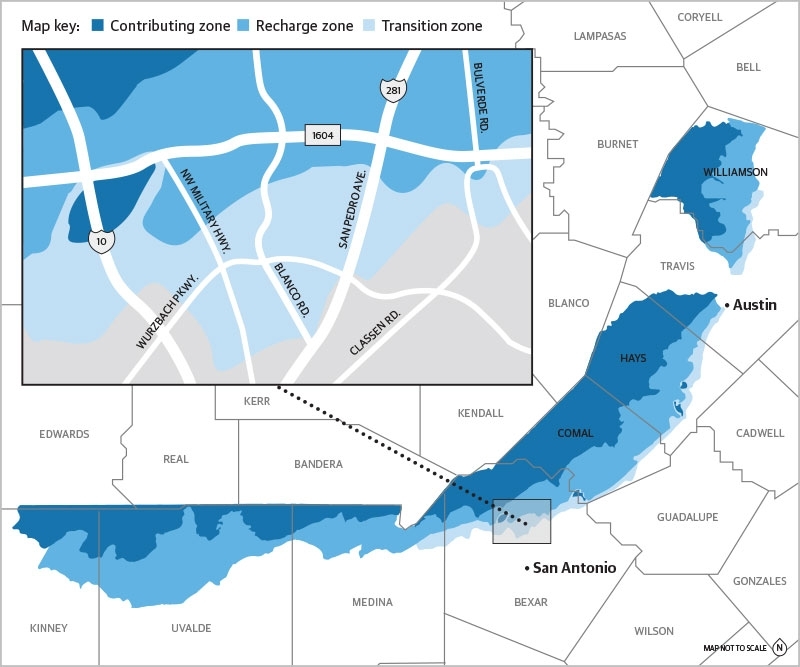The overview
With San Antonio bracing for the sixth drought year in a row and Central Texas entering another dry spring, local officials are implementing a multi-pronged strategy to maintain the city’s water supply for future generations.
“The foundation for economic vitality and quality of life in San Antonio is our water security. Without it, we have nothing. And the basis of our water security is, and always will be, the Edwards Aquifer,” Nirenberg said.
Annalisa Peace, executive director at the Greater Edwards Aquifer Alliance, said the best way to balance future development and protect the aquifer is to move development away from the recharge zone, which is the area where surface water flows directly into the aquifer.
“[The city should] concentrate new growth in the urban areas,” Peace said. “But if you’re going east of the recharge zone we don’t have any problem, if you’re going south of the recharge zone, we have no problem. So there’s a lot of developable land, and there’s a lot of developments that we are not protesting at all. We’re just concerned about this one area, and it’s geographically a pretty small area.”

The details
To protect this resource, San Antonio city officials implemented the Edwards Aquifer Protection Program in 2000. Through the program, city officials use a ⅛-cent venue sales tax to purchase land in the recharge zone.
Properties purchased by the city have been added to the Canyon State Natural Area and have been repurposed into parks, such as the Classen-Steubing Ranch Park in North San Antonio.
What else?
Another issue with maintaining the Edwards Aquifer is water quality.
Peace said the best way to protect this resource is for counties to pass impervious cover limit laws, which control the amount of land covered by impervious surfaces, such as buildings and roads.
“Most of the growth is taking place in the unincorporated areas, and counties are extremely limited as to what they can do. Counties can pass an impervious cover limit, which we prescribe as the best water quality measure that we could adopt to protect our water supplies,” Peace said.Zooming out
Another means of preserving the Edwards Aquifer’s water supply is the San Antonio Water System’s mitigation and diversification strategies.
Karen Guz, SAWS vice president of conservation, said mitigation strategies include implementing stricter watering rules, tiered fines for excessive water consumption, promoting the use of drought tolerant plants, conducting free home conservation consultations and providing irrigation efficiency rebates.
“There’s three main strategies for conservation. There’s education, getting everybody’s hearts and minds on the same page about [water usage] and understanding it and caring about it,” Guz said. “Then there’s incentives, so that’s the coupons to change your landscape or improve your irrigation system, and then there’s reasonable regulations, [such as rules] against watering in the middle of the day.”
Guz also noted that SAWS uses multiple sources to provide water to the greater San Antonio region as well as technology to lessen the city’s dependence on the Edwards Aquifer.
“[The greater San Antonio area] uses about 275,000 acre feet a year, and about half of that is Edwards Aquifer water, and then the other comes from that Vista Ridge source, which is coming from pretty far away,” Guz said. “Then we’ve got regional Carrizo water coming from a different region, [and] we have our H2Oaks facility down in South Bexar County. At that facility, we bring out what we call local Carrizo water, and we store water during wet periods.”
The H2Oaks Center utilizes Aquifer Storage and Recovery technology to store excess water from the Edwards Aquifer for later use in dry periods, desalination of brackish water and water pumped from the Carrizo Aquifer, which is a sand aquifer.
The Carrizo Aquifer supplies water to more than 60 counties in Texas, and runs from the Rio Grande in South Texas northwest in Arkansas.
Quote of note
“What I can say unequivocally is if San Antonio had not been proactive in investing in all of those supplies we just laid out, it would feel very different today. If you were to look down at Corpus Christi, they don’t have any other supplies. They’re down to their reservoirs being less than 20% and there’s no irrigation use,” Guz said.
Looking ahead
Guz said though San Antonio is bracing for continued drought conditions, the proactive investment into multiple sources of water has left the city in a better position.
•“[Our predecessors] knew that one of the first questions businesses ask when they want to move their corporations here is, ‘Do you have water?’ And we can say, ‘Yes, we do, and we have a long term plan.’ We were one of the first major cities in Texas to do that,” Guz said.





